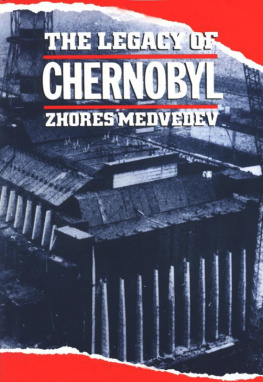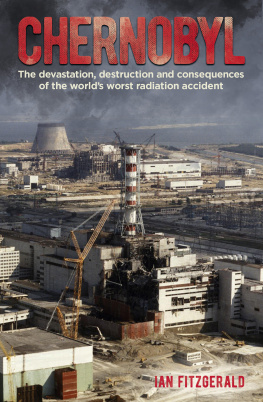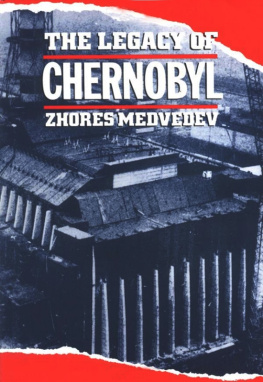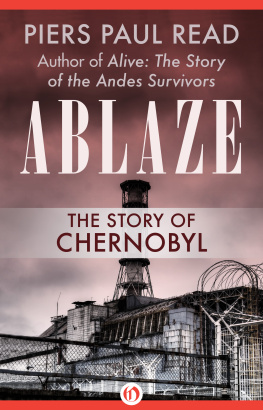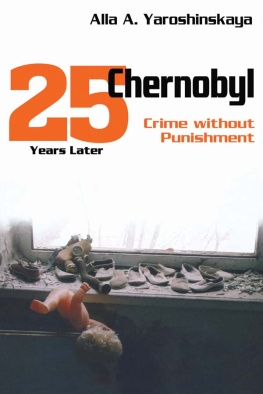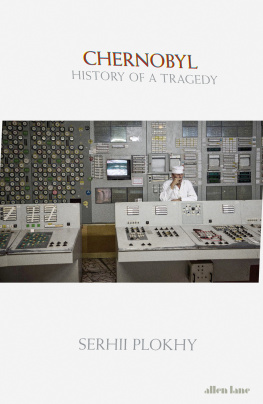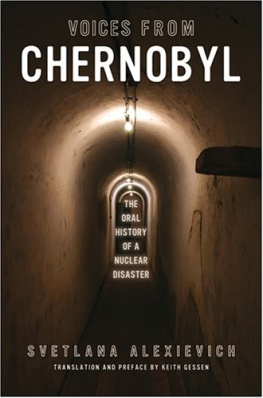Plate Acknowledgements
The author and publisher would like to thank the following for their kind permission to reproduce plates: The Independent (photograph: Dr Vladimir Shevchenko) 15; Novosti Press Agency 5, 6 (photograph: I. Kostin), 7 (photograph: V. Zufarov); Popperfoto 8; Society for Cultural Relations with the USSR 1, 2, 4, 9; Tass 3 (photograph: V. Zufarov), 10, 13 (photograph: A. Klimenko), 14 (photograph: V. Solovyev); Professor Richard Wilson 11,12.
Preface and Acknowledgements
C HERNOBYL was certainly not the most tragic accident of the last decade. But it was the most frightening catastrophe of modern industrial history. Two workers were killed immediately by the reactor explosion, and the loss of life directly caused by the Chernobyl accident was about the same as in the fire at Londons Kings Cross underground station in 1987, where 30 commuters and one fireman died.
Economically, however, Chernobyl was the most expensive accident in human history and the price the Soviet Union has to pay for it will continue to mount for decades. A young, tired and inexperienced operator, Leonid Toptunov, who died three weeks later in great pain, moved the control rods of Reactor No. 4 to only slightly below the correct position. This seemingly minor oversight resulted in a giant plume containing millions of curies of deadly radioactive aerosol being released. It moved towards the north and west and within a few days had reached nearly every country in the northern hemisphere.
The number of people who may die in the next 50 years from cancer and other health problems related to the Chernobyl accident cannot be accurately measured by health and mortality statistics even in the countries that were most affected. But millions of people who do contract a fatal cancer will believe that they might have remained alive had it not been for Chernobyl. Peoples perceptions of nuclear power have been changed forever and this will affect our future energy policies and, consequently, our history. The imagination often plays a more important role in history than simple facts.
Many books have already been published about the Chernobyl accident and many more will probably be written. Chernobylogy has become a special branch of science which will remain important for some time. It was almost inevitable that, after writing a book more than ten years ago on the nuclear disaster in the Urals, which was the most serious nuclear accident before Chernobyl, I would be tempted to write about Chernobyl. In the mid-1970s I was working alone and writing about a disaster that no one knew anything about. In fact, few people seemed to want to know. This time I have been writing about an accident that everyone knows about and I have had generous assistance and help from many experts. If I have been able to offer some new facts and insights about developments since the fateful night of 26 April 1986, I have to thank all those people who have sent me unpublished documents and reports, newspaper and magazine cuttings, and who have directed my attention to specific problems or invited me to give lectures and talks about the environmental and medical impact of Chernobyl.
As a biologist with a background in agriculture and radiobiology, it is natural that I have paid particular attention to the environmental, agricultural and health impact of the accident. But my experience of more than 20 years of research work in Soviet scientific centres, however, made it possible for me to try to offer an objective analysis of the Soviet nuclear establishment. The ten years during which I lived and worked in Obninsk, a town which was built to serve the research and design needs of Soviet nuclear energy and development, were particularly useful and contributed to my understanding of some of the complex problems which are important in discussing technical details.
Over the course of many years, living and working both in the Soviet Union and Britain, I have tried to prove that an open and co-operative society is much better protected from serious industrial accidents and other human-made calamities like hunger, malnutrition and epidemics, than are closed societies. We have known so little about accidents in communist countries because in the past even trivial problems were kept secret. Accidents were covered up and unpleasant social phenomena were hidden from the public eye. But an artificial paradise, agitprop prosperity and Potemkin villages can only be maintained for a certain length of time. And true glasnost began to emerge gradually after the Chernobyl accident.
It was not only the explosion of the reactor that made Chernobyl the turning point. It was also weather and chance. If the winds had blown in an easterly direction at the end of April 1986 rather than north-westerly, or if the reactor explosion had occurred not near Kiev, but somewhere in the Urals or Siberia, it is unlikely that the International Atomic Energy Agency (IAEA) would have been able to discuss it in detail four months later. More than 10,000 reactor accidents are known to have occurred in the rest of the world since the first reactor became critical in 1942. But for the Soviet public, Chernobyl was the first officially acknowledged nuclear accident that they were told about. And it was the first nuclear accident in the Soviet Union that Soviet officials eventually reported to the rest of the world.
In our age of high technology, supersonic speed, nuclear energy and computer-made decisions, we cannot afford too many secrets. I wanted to write this book not only to show the real scale of this particular catastrophe, but also to demolish a few more secrets and deliberate misconceptions. My intention was to be neither pro- nor anti-nuclear. I wanted to present objective and valid facts. I would like to thank the many people who have helped me search for these facts. The list of people who gave me valuable assistance in my research is very long. I shall name here only those whose contribution was most essential, even if they themselves do not immediately recognize from the text how valuable their assistance was.
First, I must thank my brother, Roy A. Medvedev, who has supplied me with cuttings and other materials from Soviet newspapers, magazines and journals, many of them very useful for this study. I am particularly grateful to James Daglish and Yasuhiko Yoshida from the Division of Public Information of the IAEA, who kindly sent me Russian and English copies of the official Soviet Chernobyl report, prepared for the post-accident meeting in Vienna in August 1986, the reports of the IAEA conference on Chernobyl in September 1987 and other IAEA materials. Dr Walter C. Pattersons book on nuclear power and his comments on the technical problems of nuclear reactors were of great value. Henry Hamman and Stuart Parrot, the authors of one of the first books on Chernobyl published in 1987, kindly supplied me with copies of many documents on the Chernobyl fallout in Europe which reflect the monitoring work carried out by the offices of the World Health Organization and other agencies. Dr Martin Dewhirst of Glasgow University also kindly sent me cuttings and copies of many articles on Chernobyl published in little-known Soviet publications like Selskaya Molodezh (Rural Youth) and Sotsialisticheskaya Industriya (Socialist Industry). His help is greatly appreciated. Professor Marvin Goldman of the University of California, Davis, who provided me with the report of the US Department of Energy Team Analyses of the Chernobyl Accident Sequence and other reports on Chernobyl by American experts helped me to understand more clearly the main design faults of the RBMK reactor models. I would also like to thank Dr Brian Wade of Harwell Laboratory, UKAEA and Mary Morrey of the National Radiological Protection Board for sending me reprints, reports and other NRPB materials relevant to the impact of Chernobyl on the United Kingdom and Western Europe. I am grateful to Dr Lennart Devell of Studsvik Nuclear Laboratory in Sweden, who sent me the reports of his laboratory and of the Swedish National Institute of Radiation Protection about Chernobyl fallout in the Nordic countries, to Wieland Eschenhagen, who provided me with the official government report on the Chernobyl fallout in the FRG, and to Kazuhisa Mori, Executive Director of Japan Atomic Industrial Forum, for giving me materials on the Chernobyl fallout in Japan and the Japanese nuclear programme.

